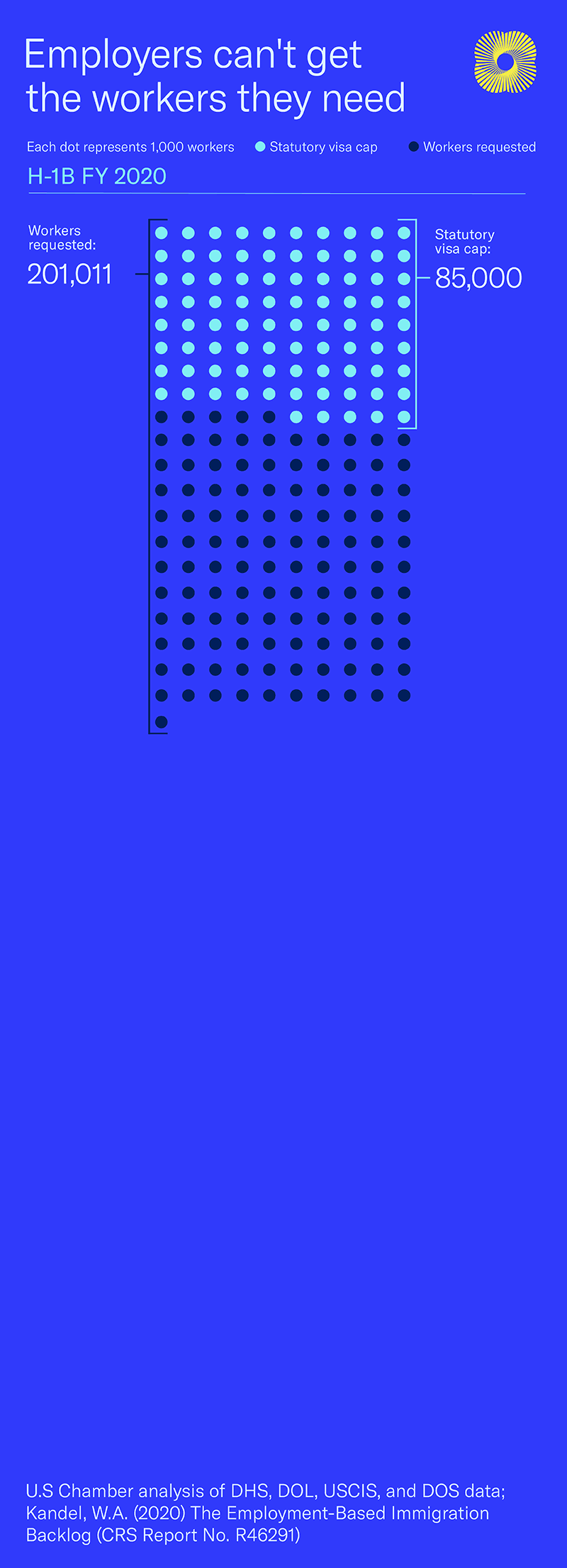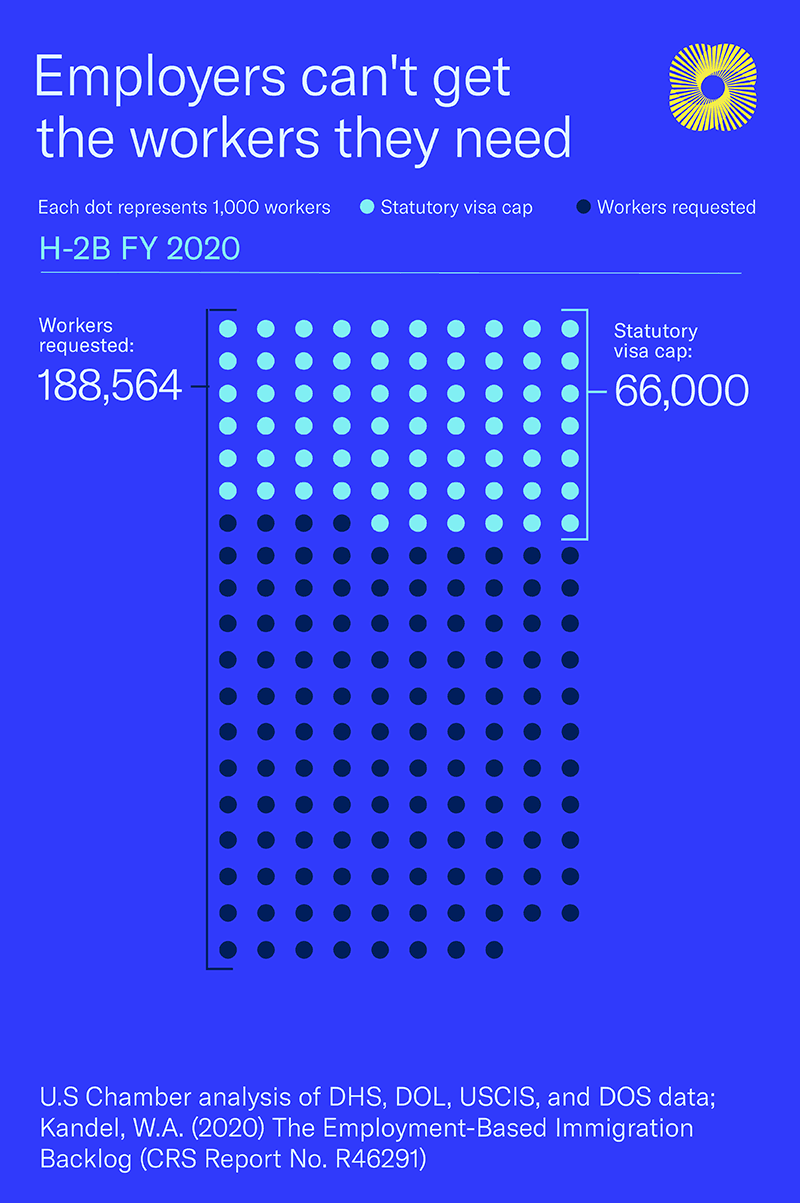 Isabella Lucy
Isabella Lucy
Graphic Designer, U.S. Chamber of Commerce
Published
July 15, 2022
Right now, we have over 10 million jobs open in the U.S., yet around 6 million unemployed workers. Moreover, labor force participation does not yet match what it was before the pandemic.
Our America Works Data Center captures these national workforce trends. This page dives deep into how our woefully inadequate immigration system is contributing to our workforce struggles.
Net International Migration to the U.S. is at its lowest levels in decades.
- +1,049,000Increase in U.S. population from immigration in 2015-2016
- +247,000Increase in U.S. population from immigration in 2020-2021
No one can deny the impact that the COVID-19 pandemic had on the significant drops in migration to the U.S., but the negative trendlines predate the pandemic.
U.S. Census Bureau data shows that net international migration to the U.S. only contributed to a 247,000 person increase to the U.S. between 2020 and 2021. Compared to the prior decade’s high of a 1,049,000 increase in our population between 2015 and 2016 due to immigration, the impact that immigration has had on U.S. population growth dropped by 76%.

Critical sources of talent for American businesses are drying up.
Fewer immigrants coming to the U.S. means that critical sources of talent for American businesses are drying up, contributing to the significant workforce problems companies are currently facing. Many of tomorrow’s innovators are today’s foreign national college students in the U.S. But these numbers have slid as well.
An estimated 1 million college educated immigrants are missing from America’s labor force. Foreign national undergraduate matriculation dropped nearly 25% between the 2019-20 and the 2020-21 academic years, and foreign national graduate student attendance dropped over 20% over the same period.

Outdated visa caps don’t meet the needs of today’s economy.
An important contributing factor to the decline in immigration to the U.S. is the antiquated, arbitrary quotas on the employment-based visa options that are available to businesses. Very low annual visa caps make it incredibly difficult for companies across a host of industries to meet their workforce needs.
The employment-based immigrant visa (green card) quotas, as well as the H-1B and H-2B quotas for temporary workers, were created in 1990 and have not been sufficiently updated to serve our national interest. In the 32 years since, the size of the U.S. economy has more than tripled from roughly $6 trillion to almost $21 trillion, and businesses have evolved from utilizing rolodexes and fax machines to using smartphones and the internet to compete in an increasingly global marketplace.

The 30-year-old visa caps are woefully insufficient to meet the needs of the American economy today. The most recent data for these programs paint a grim picture for companies struggling to meet their staffing needs, as the demand for work visas vastly outpaces the number of visas the federal government makes available.
- In FY 2021, for every three individuals seeking an employment-based immigrant visa to work in the U.S., only one of them would succeed in obtaining a visa to work in the country on a permanent basis.
- In FY 2021, for every three individuals seeking an H-2B visa to take a seasonal job in the U.S., only one of them would be able to take a job.
- In FY 2022, for every four individuals seeking an H-1B visa to work in a highly skilled field, only one of them would be able to obtain a visa.
The arbitrarily low employment-based immigrant visa quota is the primary contributing factor to the significant visa backlogs that are harming American employers and workers alike. Recent Cato Institute research shows that as of September 2021, there were approximately 1,438,758 visa petitions stuck in processing backlogs.
These backlogs prevent individual workers from being promoted and taking on new roles in their companies and prevent companies from being able to make the best use of their talent to compete in the marketplace. Moreover, the problems associated with the low employment-based green card cap contribute to the problems associated with the H-1B program for high-skilled foreign national workers.
Companies are struggling to meet their high-skilled workforce needs due to H-1B quotas.
Technology companies, financial services firms, American manufacturers, and many other employers of high-skilled workers rely upon the H-1B program to meet their workforce needs. Unfortunately, Congress has neglected to adjust the annual H-1B quota in a manner that will allow employers to meet their workforce needs. Since FY 2014, the annual quota for these visas has been reached within a few weeks of the application period commencing.
- 483,927Applications filed in spring 2022 for H-1B visas for Fiscal Year 2023
- 85,000Number of new H-1B visas that will be granted in Fiscal Year 2023
An unfortunate trend is taking place where with every passing year, more and more companies find themselves falling short when it comes to acquiring the talent they need to grow and innovate. At the same time, demand for these visas has consistently increased since FY 2020. American businesses sought 201,011 new H-1B workers in FY 2020, 275,000 workers in FY 2021, and 308,613 workers for this current fiscal year (FY 2022).

The situation is not improving for H-1B employers—in fact, it is getting worse. The H-1B application process for FY 2023 has already come and gone. For the 85,000 cap-subject H-1B visas that will be issued in the upcoming fiscal year, more than 483,000 individual applications were filed. That means only one individual will obtain a visa for every six H-1B applicants.
When the federal government will only allow American businesses to meet approximately 16.67% of their high-skilled workforce needs, it is long past time for Congress to update our immigration laws to reflect the needs of today’s economy.
There are many individuals who would love to work in the U.S. on a permanent basis, and many companies who would love to employ these people permanently. However, the lack of access to employment-based green cards pushes both companies and workers to the H-1B visa as the only option for companies to meet their labor needs in a timely fashion. Improving access to employment-based green cards would help ease some of the problems companies face when considering the H-1B as an option for meeting its workforce needs.
Seasonal businesses need more H-2B visa workers.
Seasonal employers, many of whom are small businesses, use H-2B visas to meet their staffing needs. They too are struggling to meet their workforce needs with H-2B workers.
For the first and second quarters of this current fiscal year (FY 2022), seasonal businesses have already sought 135,829 H-2B workers. This is more than double the annual statutory quota of 66,000, and only represents the needs of seasonal employers for half of this year. These struggles are not new. Seasonal employers sought 188,564 H-2B workers in FY 2020 and 206,011 H-2B workers in FY 2021.

Staffing shortages impact employers across the country seeking to fill various critical job openings, and these problems have been afflicting employers for several years. Landscapers, hotels, restaurants, carnivals, forestry companies, seafood processors, and homebuilders rely upon H-2B visa holders to meet their seasonal workforce needs.
Nevertheless, these types of firms, as well as many seasonal businesses in other industries, oftentimes find themselves short-staffed during their busy seasons.

The U.S. Chamber of Commerce has long advocated for immigration reforms that will allow companies to meet their critical workforce needs in a timely manner. Our America Works initiative acknowledges that there are many pieces to the puzzle that will help solve our nation’s workforce shortages. Instituting pro-growth immigration policies is one facet to the many policy solutions that would ameliorate the current crisis.
The U.S. Chamber and U.S. Chamber Foundation are helping employers discover and develop talent through the America Works Initiative. For more information, contact Jenna Shrove at jshrove@uschamber.com.
About the authors

Jon Baselice
Jon currently serves as the Vice President of Immigration Policy at the U.S. Chamber of Commerce. He joined the Chamber in June 2014. He works with Chamber member companies to form Chamber policy positions on various issues and he advocates for sensible immigration policies before Congress and the executive branch agencies.








